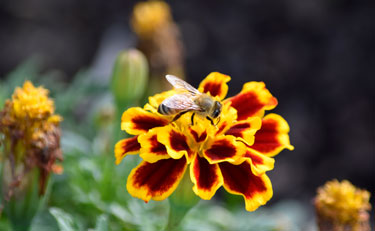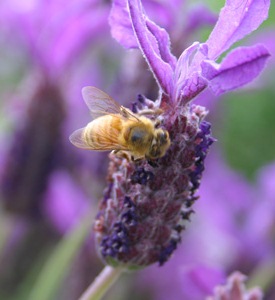Kids Go Gardening - make a buzz!
Bees are a garden’s best friends. When a bee buzzes from flower to flower to gather food for its family, pollen dust catches a ride on the bee from one flower to another. When a bit of pollen lands on a flower’s stigma and moves down its pollen tube the flower gets ‘pollinated’, which means fruit and seeds can grow inside it. Without pollination there would be no fruit or seeds. Bees are some of the world’s best pollinators of fruit and vegetable plants. And bees need our help to survive.
A single bee can visit up to 5000 flowers in one day but without suitable food sources, they can starve and become weak.
Bees need our help to survive. When something is wrong with our bees, something is wrong in the environment! Bees love all kinds of plants, but do have some particular favourites. Making a garden ‘bee-friendly’ means the bees will love to visit your place.
Plant a bee friendly flower garden
You can grow flowers from seed, or get flowering plants from the garden centre.
- Choose a sunny spot in the garden.
- Dig your soil until it is loose and crumbly OR Fill a planter box with container mix.
This is a great way to get plants to grow faster in spring when the ground is still a bit cold. You could also plant a garden in a stack of tires, old sacks, recycling bins or even an old wheelbarrow. Just make sure it has holes in the bottom for drainage. - Plant your seedlings or seeds.
- Water to keep the soil moist.
- Feed your flowers every few weeks with liquid fertiliser or worm tea from your worm farm.
A few bee favourites to plant in your garden are:
Bee Balm, Cosmos, Calendula, Delphinium, Echinacea, Lavender, Poppies, Thyme, Rosemary, Roses, Apple blossom, Orange blossom, Manuka, Pohutukawa.
Bees eat their vegetables too. Tomatoes and capsicums have yellow flowers….The colour YELLOW seems to attract the most bees. That's why bees, especially honeybees, love dandelions. Other yellow flowers, such as yellow asters, lilies and daisies, are also loved by bees.
Leave the weeds alone!
Ask Mum and Dad not to be so tidy in the garden and let some weeds flower, including in the lawn (grow a meadow!). Clovers, dandelions and plenty of other weeds are a great source of food for bees.
Bee facts
- Bees have 5 eyes! There are 3 simple eyes on top of the head, and 2 compound eyes, with numerous hexagonal facets.
- Bees need water, so place pebbles or twigs in a saucer of water so they have something to stand on and drink without falling in
- Not all bees sting. Male bees cannot, and bees are actually not out to get you! They will only usually sting if they are provoked or feel threatened. Bees are generally non-aggressive.
- Bees love bright colours. Their favourite colours are yellow, blue and purple.
18-Nov-2012

Honey bee on marigold

Honey bee on lavender

Honey bee on wild fennel

Honey bees soaking up water from the soil next to a stream


